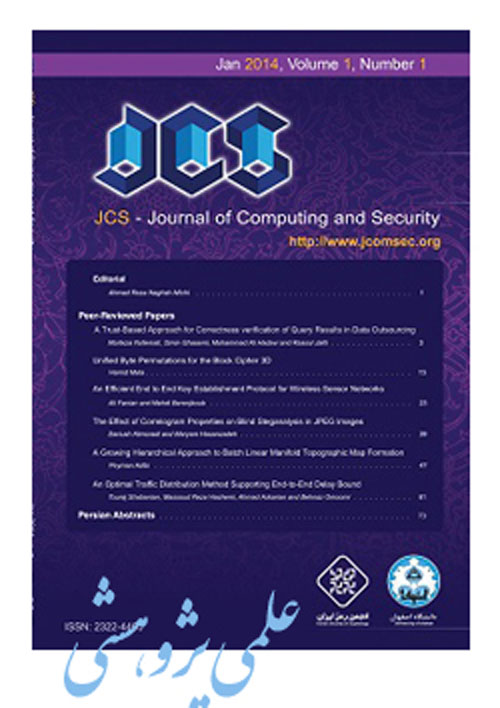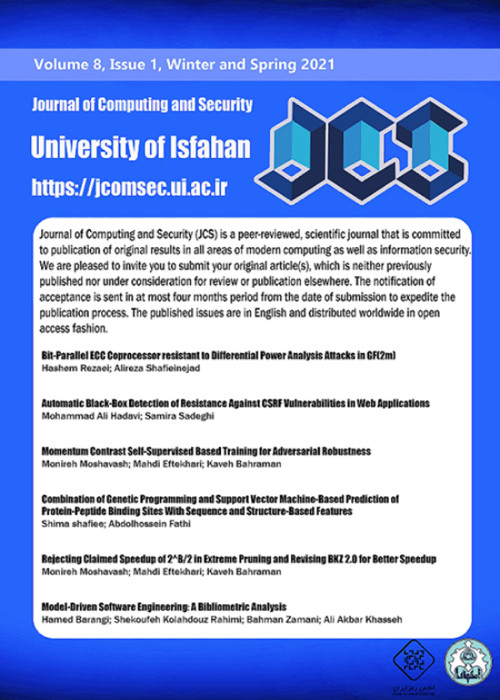فهرست مطالب

Journal of Computing and Security
Volume:4 Issue: 2, Summer and Autumn 2017
- تاریخ انتشار: 1396/08/13
- تعداد عناوین: 3
-
-
Pages 47-61Smart Grid (SG) is an intelligent managed network inclusive various data networks. Due to using the two-way data and electricity flows in SG, relations among the network elements are in an efficient way. Path finding optimization is one of the important challenges in SG. In this paper, we propose a routing protocol, namely Neuro-Fuzzy Stable Optimization Multi-Constrained Routing (NFSOMCR), to investigate the optimal path between two nodes in the SG. For this purpose, seven parameters and one cost function are used to meet the important QoS requirements of SG. Depending on the different initializations applied on the parameters, some routes with their constraints are found out by Dijkstra routing algorithm that form the inputs of the Neuro-Fuzzy system. The output of this system is the optimized cost function as well as the optimal paths between two nodes. Experimental results show that the proposed method outperforms existing works in terms of power cost and throughput.Keywords: Smart Grid (SG), Routing Optimization, Neuro-Fuzzy (NF), Performance Improvement, Quality of Service (QoS)
-
Pages 63-79Teamwork and cooperative working are increasingly needed due to the growing complexity of scientific problems and highly specialized research projects. Although many studies have been conducted on the subject of team formation in social networks, the challenge of forming a team of experts at optimum cost while maintaining maximum skill fulfillment persists. The main objective in team formation problem is to assemble a team of experts to satisfy all of the technical skill requirements of a given project while minimizing the communication and personnel cost. Electing a good leader for the team leads to better organizing and management of the entire team and also helps to lower the communication cost. Therefore, in this study three algorithms are proposed to identify a team of experts and a leader. These algorithms select the best leader and a team with the minimum cost by pruning the communication graph, identifying the effective nodes and choosing candidates for leadership according to various criteria. Moreover, a new combinational cost function is defined based on the linear combination of the objectives to minimize the personnel and communication costs. The results of experiments on a DBLP data set reveals that these algorithms are faster and more effective compared to other algorithms. The obtained results are due to the omission of excessive nodes according to the skills of experts and the project's requirements, along with choosing the leader based on appropriate criteria.Keywords: Social Network, Team Formation, Graph Pruning, Betweenness Centrality, Skill Spreading
-
Pages 81-100Nowadays, the great amount of information is stored in many data resources such as relational databases, XML documents and so on. Semantic Web is aimed to make current Web information semantic. The information of data resources should be accessed semantically, to reach this goal, it should be organized and stored under the ontology. Ontology is a key and important concept in Semantic Web. Generally, ontology is a common understanding of a domain. On the other hand, completely manually ontology construction is a time -consuming, labor intensive and prone to errors process. Therefore, an approach is required to at least semi-automatically extract ontology from data resources. Transformation approach is a convenient one to extract ontologies from various data resources. Hence, Interoperability among extracted ontologies resulted from transformation approach via mediation ontology approaches is possible and false interpretations of information with regard to different conceptualizations of a given domain is solved. In this paper, we definitely explain the transformation approach, gather the most notable methods in this field and classify them under two categories. Subsequently, we surveyed the transformation methods and finally select the best one in each category.Keywords: Survey, Semantic Web, Transformation, XML Documents, Ontologies


